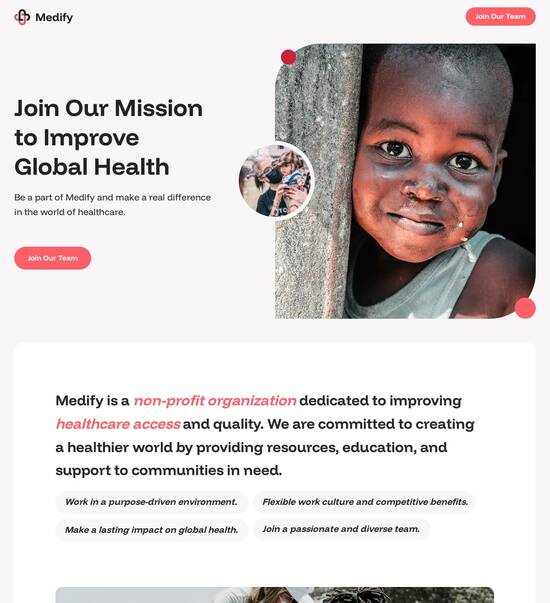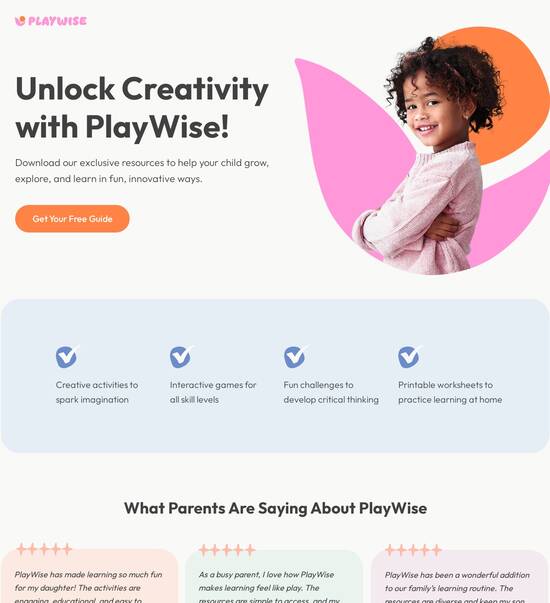
Design Safari-ready reporting page templates
Explore Similar TemplatesAbout template
Choose the best reporting page template for Safari
Recommended templates

Easy to build without coding
With the intuitive drag-and-drop builder, anyone on your team can create high-converting pages without any knowledge of code or design. Make enhancements to your landing page with custom widgets using Javascript, HTML/CSS, or third-party scripts.

Multiple layouts for any industry and goal
Select from 500+ landing page layouts built to boost conversions across industry-specific scenarios. Customize them by adjusting fonts, adding images, and generating on-brand content with the AI assistant. Quickly scale with Instablocks® and Global Blocks that you can save, reuse, and update globally.

Loads fast and looks polished on any device
Every template is responsive, which means they present professionally on any device and load blazingly fast with our Thor Render Engine. You can also power them up with Google AMP technology to deliver an unparalleled mobile experience and drive higher conversions.

Robust analytics & experimentation
Get real-time updates and reporting across all your devices, showing the number of visitors, conversions, cost-per-visitor, and cost-per-lead. Launch AI-powered experiments, run A/B tests, and use heatmaps to analyze user behavior, then optimize your landing page to maximize conversions.







Easy to build without coding
With the intuitive drag-and-drop builder, anyone on your team can create high-converting pages without any knowledge of code or design. Make enhancements to your landing page with custom widgets using Javascript, HTML/CSS, or third-party scripts.
Multiple layouts for any industry and goal
Select from 500+ landing page layouts built to boost conversions across industry-specific scenarios. Customize them by adjusting fonts, adding images, and generating on-brand content with the AI assistant. Quickly scale with Instablocks® and Global Blocks that you can save, reuse, and update globally.
Loads fast and looks polished on any device
Every template is responsive, which means they present professionally on any device and load blazingly fast with our Thor Render Engine.
Robust analytics & experimentation
Get real-time updates and reporting across all your devices, showing the number of visitors, conversions, cost-per-visitor, and cost-per-lead. Launch AI-powered experiments, run A/B tests, and use heatmaps to analyze user behavior, then optimize your landing page to maximize conversions.
All the features you need to build lead-generating landing pages
Explore more featuresLearn how to build top-performing landing pages for any goal
FAQs
Leading the way in building high-performing landing pages





A comprehensive guide to using Instapage for optimizing landing pages
Instapage is an all-in-one platform designed to help marketing professionals create, optimize, and maximize their digital campaigns. With a variety of powerful tools and resources, this guide will walk you through the essential steps to enhancing your landing pages efficiently. This includes using high-converting templates, optimizing page performance, and personalizing content for targeted audiences.
Understanding the power of Instapage
Instapage offers a flexible page creation platform that simplifies the process of building landing pages. With over 100 conversion-focused templates and customizable layouts, users can create landing pages without any coding skills. This feature is crucial for marketers within various sectors including business services, education, and financial services, ensuring they can launch campaigns quickly and effectively.
- Access to ready-made templates: Choose from a library of high-converting templates that can be easily customized to fit your brand.
- User-friendly builder: The intuitive drag-and-drop interface allows marketers to create pages effortlessly without any technical knowledge.
- Conversion optimization tools: Built-in optimization features help track performance, ensuring your landing pages continually improve their conversion rates.
Steps to create high-converting landing pages
Building an effective landing page involves several critical steps.
- Select a template: Start with a high-quality template that aligns with your campaign goals. This serves as the foundation to modify and enhance.
- Customize your content: Tailor the text and images to resonate with your target audience, ensuring clarity and alignment with your marketing message.
- Implement lead generation elements: Utilize Instapage’s tools such as forms and call-to-action buttons to capture valuable leads directly from your page.
Optimizing landing pages for success
Once your landing pages are set up, it’s crucial to monitor and optimize their performance.
- Utilize A/B testing: Experiment with different versions of your landing page to discover which elements yield the best results in terms of conversions.
- Analyze heatmaps: Use heatmap tools to visually understand user behavior and identify which areas of the page are attracting attention.
- Leverage analytics: The Instapage dashboard offers in-depth analytics that help you track engagement metrics and refine your strategy over time.
By following these steps, marketers can effectively utilize Instapage's capabilities to create conversion-focused landing pages.
In conclusion, Instapage serves as an invaluable tool for enhancing online marketing strategies and optimizing landing pages for maximum ROI.
Ready to elevate your digital marketing? Start optimizing your landing pages with Instapage today!
People also ask about Reporting page template optimized for Safari
Understanding the Reporting Page Template: Maximizing Optimization for Safari Users
The importance of specialized reporting templates
Specialized reporting templates are critical tools that help transform raw data into visually compelling formats. These templates not only streamline the way information is presented but also enhance data visualization, making it more digestible for stakeholders. Well-structured reports can highlight key insights that drive strategic decisions and facilitate a deeper understanding of complex datasets. Furthermore, they enable teams to communicate findings efficiently, paving the way for informed decision-making and action.
Safari users often have unique requirements that differ from users of other browsers. This is essential to consider because each browser may interpret design elements and scripts differently, potentially impacting the user experience significantly. Therefore, developing reporting templates optimized specifically for Safari is paramount, allowing brands to ensure consistent performance and design fidelity across their audience.
Key features of the Safari-optimized reporting page template
Key features of a Safari-optimized reporting page template include responsiveness, which ensures a smooth user experience across various devices. This is particularly important in today’s mobile-first world, where users access data reports on different screens. A responsive design adapts to the user’s device, making information accessible whether viewed on desktops, tablets, or smartphones. Additionally, incorporating integration with existing tools like Google Analytics and CRM systems allows for a seamless workflow and enhances usability, making it easier for users to generate reports using familiar platforms.
Another vital feature is the availability of customizable fields. These templates can be tailored to individual preferences and requirements, allowing users to personalize reports to better reflect their needs or those of their teams. This flexibility in design can be crucial for businesses that require specific data metrics or formats, enabling them to present information that aligns with their objectives.
Technical underpinnings: Technologies behind the template
The technical foundation of a reporting page template optimized for Safari heavily relies on HTML5 and CSS3. These technologies provide a robust structure and design capabilities that ensure the template functions efficiently across various environments. HTML5 allows for semantic markup, which improves accessibility and SEO performance, while CSS3 facilitates advanced styling options that enhance visual appeal. When combined, these technologies help create a stable environment that visually engages users regardless of the device they are using.
JavaScript plays a crucial role in enhancing interactivity within the reporting page template. Through dynamic content updates and animations, users can interact with the data, drilling down to specifics without cumbersome page reloads. Furthermore, optimizing performance via techniques such as code minification, image compression, and leveraging caching can significantly improve load times, particularly on Safari, where efficient performance is critical.
Workflow enhancements offered by the reporting template
The reporting template is designed to streamline the report generation process, making it significantly less time-consuming and more efficient. With pre-built layouts and automated features, marketers and data analysts can swiftly compile necessary information without starting from scratch. This allows teams to focus more on analysis rather than formatting and structuring data, thus enhancing productivity.
Furthermore, collaborative features integrated into these templates promote team inputs and facilitate reviews. Teams can easily share reports and receive real-time feedback, enhancing teamwork and ensuring everyone is aligned on the insights being presented. Automation of repetitive tasks such as data collection and report customization also plays a vital role in saving time. Automated reporting minimizes manual intervention and human error, further boosting efficiency.
Setting up your reporting template for Safari
Setting up a Safari-optimized reporting template requires careful installation and configuration. Start by downloading the template from your preferred website, ensuring that it is specifically marked for Safari compatibility. After downloading, follow the on-screen installation prompts to integrate the template with your existing systems. It’s vital to check for browser updates and ensure compatibility across different versions of Safari to avoid potential issues.
Common errors during setup often relate to misalignment in data sources or incorrect configurations in integrations. To prevent issues, double-check API connections and ensure that all plugins or external tools are compatible with Safari. Additionally, it is recommended to customize the fields and visual elements to fit your brand's identity, ensuring the reports are not only functional but visually on-brand and effective in communication.
Engaging with your audience through reports
Engagement with audiences through reports is essential for effective communication of insights. To present information clearly, reports should adopt a structured layout that guides viewers through the content naturally. This involves using headlines, subheadings, and bullet points to break down complex information into easily digestible sections. By segmenting data into smaller, more manageable parts, the chances of retention and understanding increase dramatically.
Visuals such as graphs, charts, and infographics are equally important as they provide immediate context and assist in illustrating key findings. These elements not only serve to embellish the report but also enable audiences to grasp essential points quickly without wading through extensive text. It's beneficial to study case examples from various industries that successfully utilize these techniques. For instance, an educational report utilizing infographics can effectively communicate trends in student performance without overwhelming stakeholders with raw numbers.
Frequently asked questions: Addressing common queries
A frequent question regarding reporting functionalities is how they vary based on browser preferences. Different browsers interpret coding and rendering differently, which can lead to discrepancies in how reports appear to users. As a result, ensuring optimization for Safari not only involves functional elements but also design aspects, ensuring every user has a consistent experience regardless of their chosen browser.
Another common query relates to which metrics should be prioritized in reports for optimal engagement. Metrics such as conversion rates, user engagement levels, and churn rates tend to lead to actionable insights and thus should be prominently featured. Lastly, understanding the importance of mobile optimization is crucial for Safari users who primarily access content via mobile devices. Businesses should prioritize mobile-friendly designs and functionalities to enhance user experience and engagement.
Communities and collectives: Building knowledge around reporting tools
Online forums and groups dedicated to reporting solutions can provide invaluable resources for users. These communities offer platforms where marketers, analysts, and developers can share insights, best practices, and troubleshooting tips regarding reporting tools. Participation in such communities encourages collaboration among users, leading to improved solutions that meet the collective needs of various industries.
User feedback plays a significant role in the evolution of reporting template features. By actively seeking out user experiences, developers can identify common pain points and enhance their products accordingly. This iterative feedback loop ensures that reporting templates continue to evolve, adapt, and ultimately serve the changing needs of their users effectively.
Connecting diverse teams through reporting
Reporting tools can facilitate inter-departmental collaboration, making it easier for teams to work together and share insights. By providing a centralized location for reports, teams can avoid communication breakdowns that often occur when datasets are scattered across different platforms. A case study that highlights this involves marketing and sales teams that collaborate closely on analyzing customer feedback, using reporting templates to share findings that drive unified strategies.
Moreover, maintaining communication across multiple locations is simplified with cloud-based reporting templates. These tools allow teams to easily access, modify, and share reports in real time, thus breaking down geographical barriers. Strategies to maintain effective communication include regular virtual check-ins and ensuring that each department understands its role in the reporting process.
Exploring the future of reporting templates: What’s next?
The future of reporting templates lies in enhancing their compatibility and usability across platforms like Safari. Upcoming features may include advanced customization options and more intuitive design tools, allowing users to create reports that not only inform but also inspire. As reporting technology evolves, incorporating user-friendly data visualization techniques will play a crucial role in keeping audiences engaged and informed.
Additionally, the growing significance of privacy and data security in reporting cannot be overlooked. As regulatory environments tighten, ensuring that reports comply with privacy standards will be increasingly important. Trends to watch include the rise of real-time analytics, enabling organizations to make faster decisions through more immediate access to data.
Maximizing the benefits of reporting pages
To maximize the benefits of using reporting pages, it is crucial for individuals and organizations to recognize the key takeaways from utilizing these templates. Firstly, understanding the unique features and capabilities of an optimized reporting template allows teams to leverage these tools to their fullest potential. By analyzing user data and the effectiveness of reports, further refinements can be made to enhance output and ensure that information is presented in a clear, engaging manner.
Creating a feedback loop is paramount for continuous improvement. This process involves soliciting input from report recipients regarding the clarity and effectiveness of the reports. Regularly reviewing these inputs can help refine the reporting process, making it more efficient and valuable. Ultimately, a well-structured reporting page optimized for Safari can significantly enhance the ability to communicate insights, thereby improving overall productivity.
Ready to skyrocket conversions?
Supercharge your ad campaigns with high-performing landing pages
Get started














